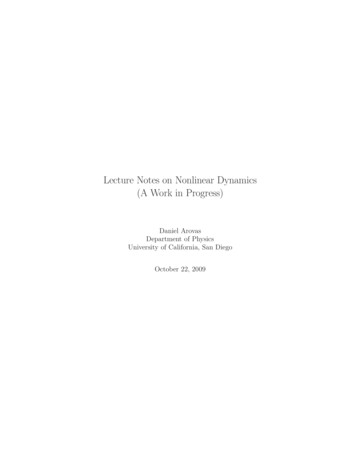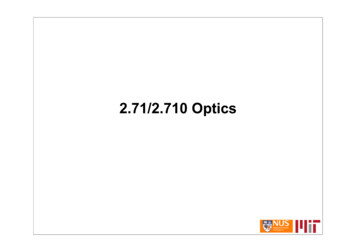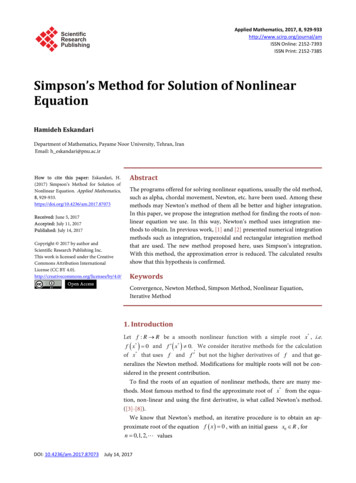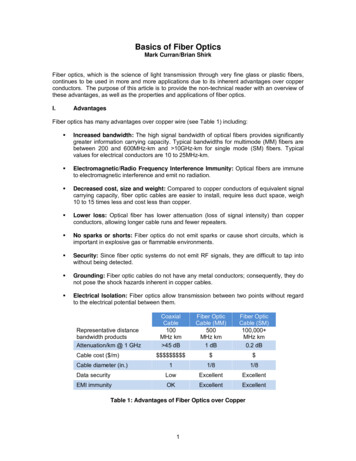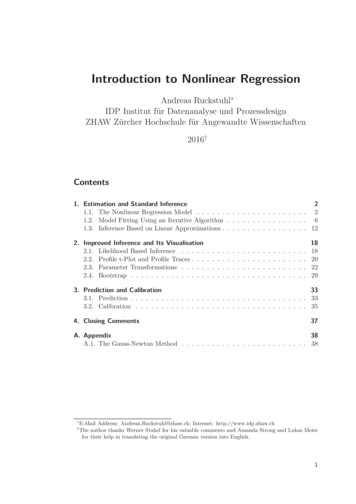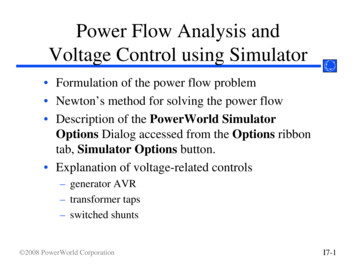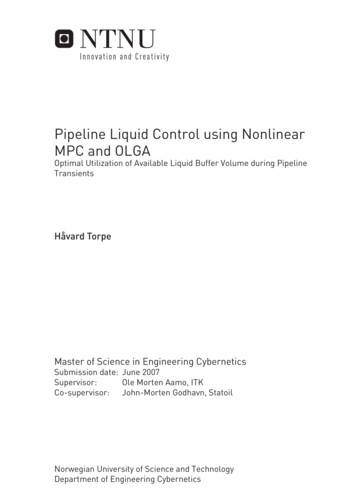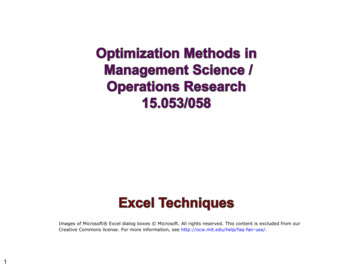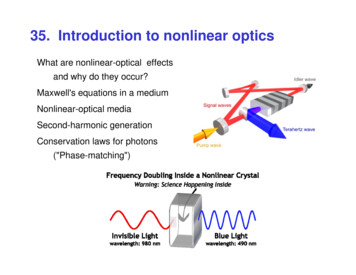
Transcription
35. Introduction to nonlinear opticsWhat are nonlinear-optical effectsand why do they occur?Maxwell's equations in a mediumNonlinear-optical mediaSecond-harmonic generationConservation laws for photons("Phase-matching")
Nonlinear Optics can producemany exotic effectsSending infrared light into a crystalyielded this display of green light:Nonlinear optics allows us tochange the color of a light beam,to change its shape in space andtime, and to create the shortestevents ever made by humans.Nonlinear optical phenomena arethe basis of many components ofoptical communications systems,optical sensing, and materialsresearch.
Why do nonlinear-optical effects occur?Recall that, in normal linear optics, a light wave acts on a molecule,which vibrates and then emits its own light wave that interferes withthe original light wave.We can also imagine thisprocess in terms of themolecular energy levels,using arrows for thephoton energies:
Why do nonlinear-optical effectsoccur? (continued)Now, suppose the irradiance is high enough that many moleculesare excited to the higher-energy state. This state can then act asthe lower level for additional excitation. This yields vibrations at allfrequencies corresponding to all energy differences betweenpopulated states.This picture is a little bitmisleading because it suggeststhat the intermediate energy levelis necessary, which isn’t true.
Reminder: Maxwell's Equations in a MediumThe induced polarization, P, contains the effect of the medium.The inhomogeneous wave equation (in one dimension): 2 E 1 2 E 2 P 2 2 0 22dt xc0 tThe polarization is usually proportional to the electric field: P 0 E unitless proportionality constantcalled the “susceptibility”Recall, for example, in the forced oscillator model, we found:Ne2 / 0 meIn this particularP(t ) 0E t model, this is .2 0 0 j Then, the wave equation becomes: 2 E 1 2 E 2 2 2 0 2 0 E 2 xc0 tdt1 2 E 1 2 E 0 0 0since2or2c0 x 2 t 2c0
Reminder: Maxwell's Equations in a Medium 2 E 1 2 E 0 x 2c02 t 2Of course this is the same equation as the usual homogeneousequation (waves in empty space), as long as we define:1 1 22cc0And, we call the quantity1 the “refractive index”.So, we can describe light in a medium just like light in vacuum, aslong as we take into account the (possibly complex) refractive indexcorrection to the speed.But this only worked because P was proportional to E What if it isn’t? Then P is a non-linear function of E!
Maxwell's Equations in a Nonlinear MediumNonlinear optics is what happens when the polarization includeshigher-order (nonlinear!) terms in the electric field:P 0 (1) E (2) E 2 (3) E 3 . PLinear Pnon linearThen the wave equation looks like this: 2 Pnon linear 2 E n2 2 E 2 2 02 xc tdt 2Now instead of just oneproportionality constant ,we have a family of them: (1), (2), (3), etc.The linear term can be treated in the same way as before, givingrise to the refractive index. But the non-linear term is a challenge 22 2 E n2 2 E (2)2(3)3EE 0 00 02222 2 xc tdtdtUsually, (2), (3), etc., are very small and can be ignored. But not if E is big
The effects of the non-linear termsWhat sort of effect does this non-linear term have?If we write the field as:thenE (t ) E0 exp( j t ) E0* exp( j t )E (t ) E exp(2 j t ) 2 E0 E0*2 exp( 2 j t )2202terms that vary at a new frequency, the 2nd harmonic, 2 !Nonlinearity can lead to the generation of new frequency components.This can be extremely useful:Frequency doubling crystal:1064 nm532 nm
The birth of nonlinear opticsIn 1961, P. Franken et al. focused a pulsed ruby laser ( 694 nm)into a quartz crystal. With about 3 joules of energy in the red pulse,they generated a few nanojoules of blue light ( 347 nm)from Phys. Rev. Lett., 7, 118 (1961)The copy editor thought it was a speck of dirt, and removed it .
Sum and difference frequency generationSuppose there are two different-color beams present, not just one:E (t ) E1 exp( j 1t ) E1* exp( j 1t ) E2 exp( j 2t ) E2* exp( j 2t )Then E(t)2 has 16 terms:E(t )2 E12 exp(2 j 1t ) E1*2 exp( 2 j 1t ) E22 exp(2 j 2t ) E2*2 exp( 2 j 2t )2nd harmonic of 12nd harmonic of 2 2E1E2 exp( j 1 2 t ) 2E1* E2* exp( j 1 2 t )sum frequency 2E1E2 exp( j 1 2 t ) 2E1* E2* exp( j 1 2 t )difference frequency 2 E1 2 E222zero frequency - known as “optical rectification”This is an awful lot of processes - do they all occur simultaneously?Which one dominates (if any)? What determines the efficiency?
Complicated nonlinear-optical effects can occur.Nonlinear-optical processesare often referred to as:"N-wave-mixing processes"where N is the number ofphotons involved (includingthe emitted one).Emitted-lightphoton energyFrequency doubling is a“three-wave mixing” process.This cartoon illustrates a 6-wave mixing process.It would involve the (5) term in the wave equation.The more photons (i.e., the higher the order) the weaker the effect,however. Very-high-order effects can be seen, but they requirevery high irradiance, since usually (2) (3) (4) (5)
Conservation laws for photons in nonlinear opticsEnergy must be conserved. Recall thatthe energy of a photon is . Thus: 1 2 3 4 5 0Photon momentum must also be conserved.The momentum of a photon is k, so: k1 k2 k3 k4 k5 k0 Unfortunately, k0 may not correspond toa light wave at frequency 0!Satisfying these two relations simultaneouslyis called "phase-matching."No more than one of the many possible N-wave mixing processes can bephase-matched at any one time. Most of the time, none of them can.
Phase-matching: an exampleConsider the 2nd harmonic generation process: outEnergy conservation requires: innonlinearmaterial Momentum conservation requires: k k k 2 1 blue photonRefractiveindex2 red photonsn Frequency2 c n n 2 cn(2 ) n( )2 cUnfortunately, dispersion prevents this from ever happening!
Phase-matching Second-HarmonicGeneration using birefringenceUsing this, we can satisfy thephase-matching condition.For example:Use the extraordinary polarizationfor and the ordinary for 2 :Refractive indexBirefringent materials have different refractive indices for differentpolarizations: the “Ordinary” and “Extraordinary” refractive indices!nenoFrequency 2 no (2 ) ne ( )ne depends on propagation angle, so by rotating thebirefringent crystal, we can tune the condition precisely bymoving the red curve up and down relative to the blue curve.
Light created in real crystalsFar fromphase-matching:SHG crystalInput beamCloser tophase-matching:Input beamweak outputbeamSHG crystalStrong outputbeamNote that SH beam is brighter as phase-matching is achieved.
Second-Harmonic GenerationSHG crystals at LawrenceLivermore National LaboratoryThese crystals convert as much as80% of the input light to its secondharmonic. Then additional crystalsproduce the third harmonic withsimilar efficiency!Cascading two second-orderprocesses is usually more efficientthan a single-step third-orderprocess.
Another second-order process:difference-frequency generationExample: consider two optical waves with similar frequencies 1 and 2: (2) Etot t E0 exp j 1t E0 exp j 2t 2 E0 cos avet cos t Suppose we illuminate asemiconductor with thissuperposition oftwo light waves, like this: Electrons in the solidare unable to oscillateas rapidly as ave, butthey can oscillate asrapidly as if it isnot too large.Oscillating currents inducedin the material produceradiation at This is the origin of (2)( 2 – 1)in semiconductors.
Difference-Frequency Generation: OpticalParametric Generation, Amplification, OscillationDifference-frequency generation takes many useful forms. 1 3 2 3 1 3Difference-frequency generation(also called Parametric Down-Conversion) 1 1 3 2 1 2Optical ParametricGeneration (OPG)"signal""idler"By convention: signal idler 1 3 2mirrorOptical ParametricAmplification (OPA)Optical ParametricOscillation (OPO)All of these are (2) processes (three-wave mixing).mirror
Optical Parametric Oscillator (OPO)Like a laser, but much more widely tunable!No energy is stored in the nonlinearcrystal (unlike the gain medium of alaser), so heating is not an issue.A commonly used and powerfulmethod for generating tunablenear- and mid-infrared light.
DFG is one common method forgeneration of terahertz radiationChanging by tuning onelaser results in tuning of theoutput THz frequency.One can even put this DFGprocess into a laser cavity,creating a terahertz OPO.
Another 2nd-order process: Electro-opticsApplying a voltage to a crystal changes its refractive indices andintroduces birefringence. In a sense, this is sum-frequencygeneration with a beam of zero frequency (but not zero field!).VPockels cellPolarizerIf V 0, the pulsepolarization doesn’tchange.If V Vp, the pulsepolarization switches to itsorthogonal state.The Pockels effect can be described as a (2) nonlinear opticalinteraction, where E2E( ) E( 0). Sum frequency is at 0 .
3rd order effects can also be important22 2 E n2 2 E (2)2(3)3 E E 0 00 02222 2 xc tdtdtIn certain specific situations, one can find that (2) is identically zero.In these cases, the largest non-linear contribution comes from the (3) term. third harmonic generation other more unusual effects:self icalfilaments
Sending infrared light into a crystal yielded this display of green light: Nonlinear optics allows us to change the color of a light beam, to change its shape in space and time, and to create the shortest events ever made by humans. Nonlinear optical phenomena are the ba
